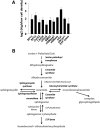Cell density-dependent reduction of dihydroceramide desaturase activity in neuroblastoma cells
- PMID: 22377532
- PMCID: PMC3329391
- DOI: 10.1194/jlr.M019075
Cell density-dependent reduction of dihydroceramide desaturase activity in neuroblastoma cells
Abstract
We applied a metabolic approach to investigate the role of sphingolipids in cell density-induced growth arrest in neuroblastoma cells. Our data revealed that sphingolipid metabolism in neuroblastoma cells significantly differs depending on the cells' population context. At high cell density, cells exhibited G0/G1 cell-cycle arrest and reduced ceramide, monohexosylceramide, and sphingomyelin, whereas dihydroceramide was significantly increased. In addition, our metabolic-labeling experiments showed that neuroblastoma cells at high cell density preferentially synthesized very long chain (VLC) sphingolipids and dramatically decreased synthesis of sphingosine-1-phosphate (S1P). Moreover, densely populated neuroblastoma cells showed increased message levels of both anabolic and catabolic enzymes of the sphingolipid pathway. Notably, our metabolic-labeling experiments indicated reduced dihydroceramide desaturase activity at confluence, which was confirmed by direct measurement of dihydroceramide desaturase activity in situ and in vitro. Importantly, we could reduce dihydroceramide desaturase activity in low-density cells by applying conditional media from high-density cells, as well as by adding reducing agents, such as DTT and L-cysteine to the media. In conclusion, our data suggest a role of the sphingolipid pathway, dihydroceramides desaturase in particular, in confluence-induced growth arrest in neuroblastoma cells.
Figures









Similar articles
-
Involvement of dihydroceramide desaturase in cell cycle progression in human neuroblastoma cells.J Biol Chem. 2007 Jun 8;282(23):16718-28. doi: 10.1074/jbc.M700647200. Epub 2007 Feb 5. J Biol Chem. 2007. PMID: 17283068 Free PMC article.
-
C22:0- and C24:0-dihydroceramides confer mixed cytotoxicity in T-cell acute lymphoblastic leukemia cell lines.PLoS One. 2013 Sep 9;8(9):e74768. doi: 10.1371/journal.pone.0074768. eCollection 2013. PLoS One. 2013. PMID: 24040340 Free PMC article.
-
Dihydroceramide desaturase and dihydrosphingolipids: debutant players in the sphingolipid arena.Prog Lipid Res. 2012 Apr;51(2):82-94. doi: 10.1016/j.plipres.2011.12.002. Epub 2011 Dec 17. Prog Lipid Res. 2012. PMID: 22200621 Review.
-
Gamma-tocotrienol profoundly alters sphingolipids in cancer cells by inhibition of dihydroceramide desaturase and possibly activation of sphingolipid hydrolysis during prolonged treatment.J Nutr Biochem. 2017 Aug;46:49-56. doi: 10.1016/j.jnutbio.2017.04.003. Epub 2017 Apr 12. J Nutr Biochem. 2017. PMID: 28456081 Free PMC article.
-
Dihydroceramide desaturase 1, the gatekeeper of ceramide induced lipotoxicity.Biochim Biophys Acta. 2015 Jan;1851(1):40-50. doi: 10.1016/j.bbalip.2014.09.021. Epub 2014 Oct 2. Biochim Biophys Acta. 2015. PMID: 25283058 Review.
Cited by
-
Sphingosine kinase 1/S1P receptor signaling axis is essential for cellular uptake of Neisseria meningitidis in brain endothelial cells.PLoS Pathog. 2023 Nov 30;19(11):e1011842. doi: 10.1371/journal.ppat.1011842. eCollection 2023 Nov. PLoS Pathog. 2023. PMID: 38033162 Free PMC article.
-
Don't Be Surprised When These Surprise You: Some Infrequently Studied Sphingoid Bases, Metabolites, and Factors That Should Be Kept in Mind During Sphingolipidomic Studies.Int J Mol Sci. 2025 Jan 14;26(2):650. doi: 10.3390/ijms26020650. Int J Mol Sci. 2025. PMID: 39859363 Free PMC article. Review.
-
Opaganib Downregulates N-Myc Expression and Suppresses In Vitro and In Vivo Growth of Neuroblastoma Cells.Cancers (Basel). 2024 May 5;16(9):1779. doi: 10.3390/cancers16091779. Cancers (Basel). 2024. PMID: 38730731 Free PMC article.
-
Inhibition of sphingolipid metabolism enhances resveratrol chemotherapy in human gastric cancer cells.Biomol Ther (Seoul). 2012 Sep;20(5):470-6. doi: 10.4062/biomolther.2012.20.5.470. Biomol Ther (Seoul). 2012. PMID: 24009836 Free PMC article.
-
Distinct signaling roles of ceramide species in yeast revealed through systematic perturbation and systems biology analyses.Sci Signal. 2013 Oct 29;6(299):rs14. doi: 10.1126/scisignal.2004515. Sci Signal. 2013. PMID: 24170935 Free PMC article.
References
-
- Hannun Y. A., Obeid L. M. 2008. Principles of bioactive lipid signalling: lessons from sphingolipids. Nat. Rev. Mol. Cell Biol. 9: 139–150 - PubMed
-
- Nelson P. J., Daniel T. O. 2002. Emerging targets: molecular mechanisms of cell contact-mediated growth control. Kidney Int. 61: S99–S105 - PubMed
-
- Hall P. A., Lane D. P. 1994. Genetics of growth arrest and cell death: key determinants of tissue homeostasis. Eur. J. Cancer. 30A: 2001–2012 - PubMed
-
- Kopitz J., Muhl C., Ehemann V., Lehmann C., Cantz M. 1997. Effects of cell surface ganglioside sialidase inhibition on growth control and differentiation of human neuroblastoma cells. Eur. J. Cell Biol. 73: 1–9 - PubMed
-
- Rösner H., Greis C., Rodemann H. P. 1990. Density-dependent expression of ganglioside GM3 by human skin fibroblasts in an all-or-none fashion, as a possible modulator of cell growth in vitro. Exp. Cell Res. 190: 161–169 - PubMed
Publication types
MeSH terms
Substances
Grants and funding
LinkOut - more resources
Full Text Sources
Medical
Molecular Biology Databases

